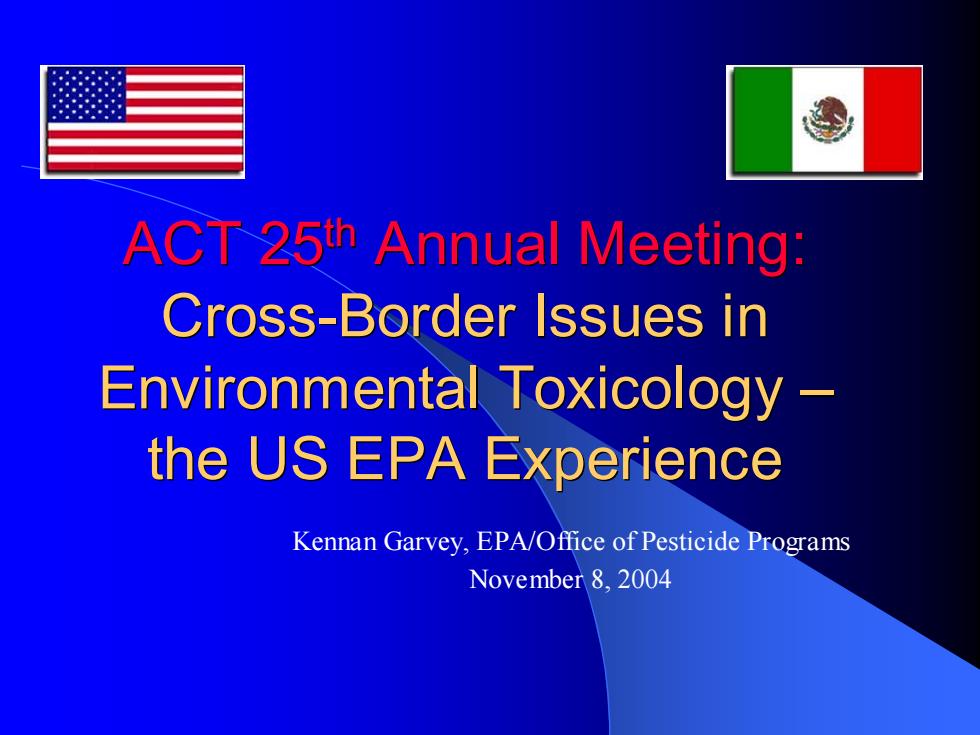
ACT 25th Annual Meeting: Cross-Border Issues in Environmental Toxicology the US EPA Experience Kennan Garvey,EPA/Office of Pesticide Programs November 8,2004
ACT 25th Annual Meeting: Annual Meeting: Cross-Border Issues in Border Issues in Environmental Toxicology Environmental Toxicology – the US EPA Experience the US EPA Experience Kennan Garvey, EPA/Office of Pesticide Programs November 8, 2004
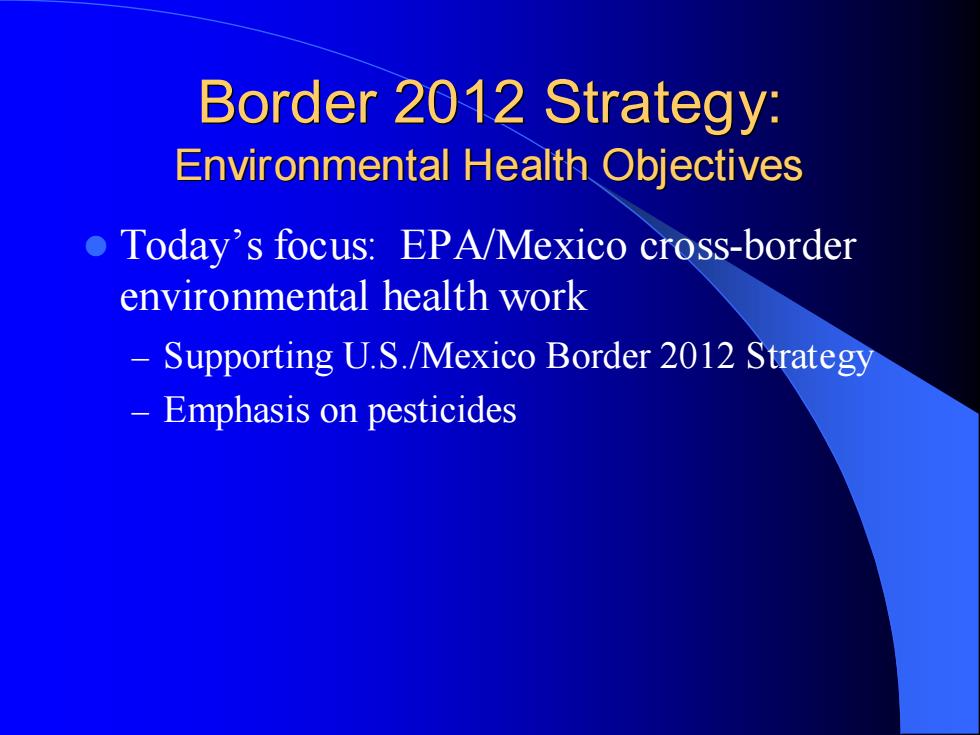
Border 2012 Strategy: Environmental Health Objectives Today's focus:EPA/Mexico cross-border environmental health work Supporting U.S./Mexico Border 2012 Strategy Emphasis on pesticides
Border 2012 Strategy: Border 2012 Strategy: Environmental Health Objectives Environmental Health Objectives z Today’s focus: EPA/Mexico cross-border environmental health work – Supporting U.S./Mexico Border 2012 Strategy – Emphasis on pesticides
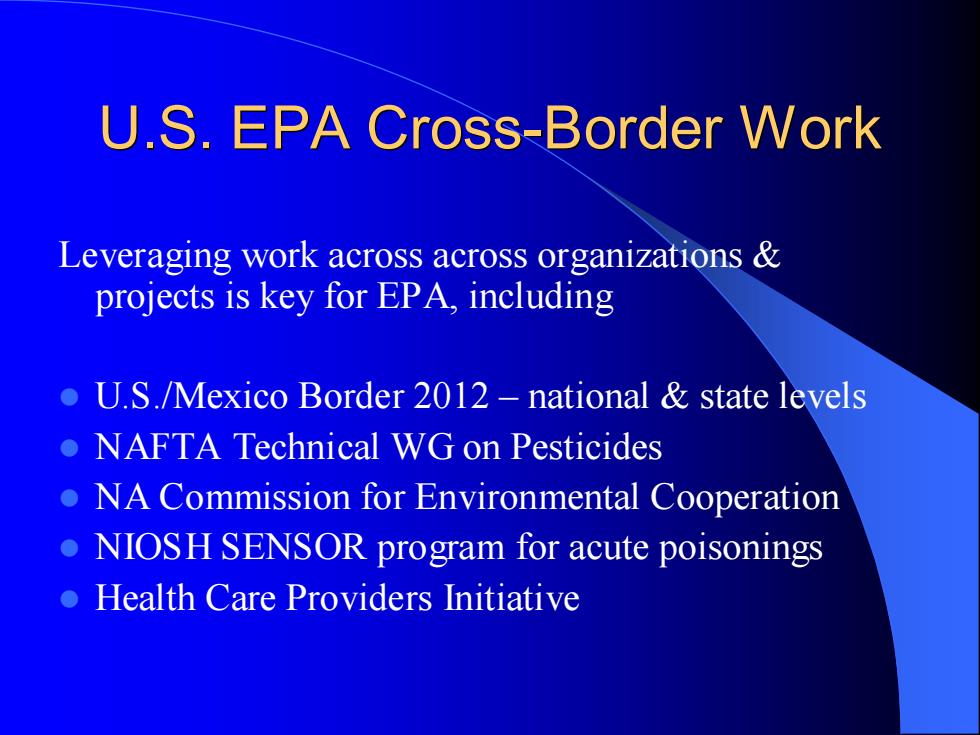
U.S.EPA Cross-Border Work Leveraging work across across organizations projects is key for EPA,including U.S./Mexico Border 2012-national state levels NAFTA Technical WG on Pesticides NA Commission for Environmental Cooperation NIOSH SENSOR program for acute poisonings Health Care Providers Initiative
U.S. EPA Cross U.S. EPA Cross -Border Work Border Work Leveraging work across across organizations & projects is key for EPA, including z U.S./Mexico Border 2012 – national & state levels z NAFTA Technical WG on Pesticides z NA Commission for Environmental Cooperation z NIOSH SENSOR program for acute poisonings z Health Care Providers Initiative
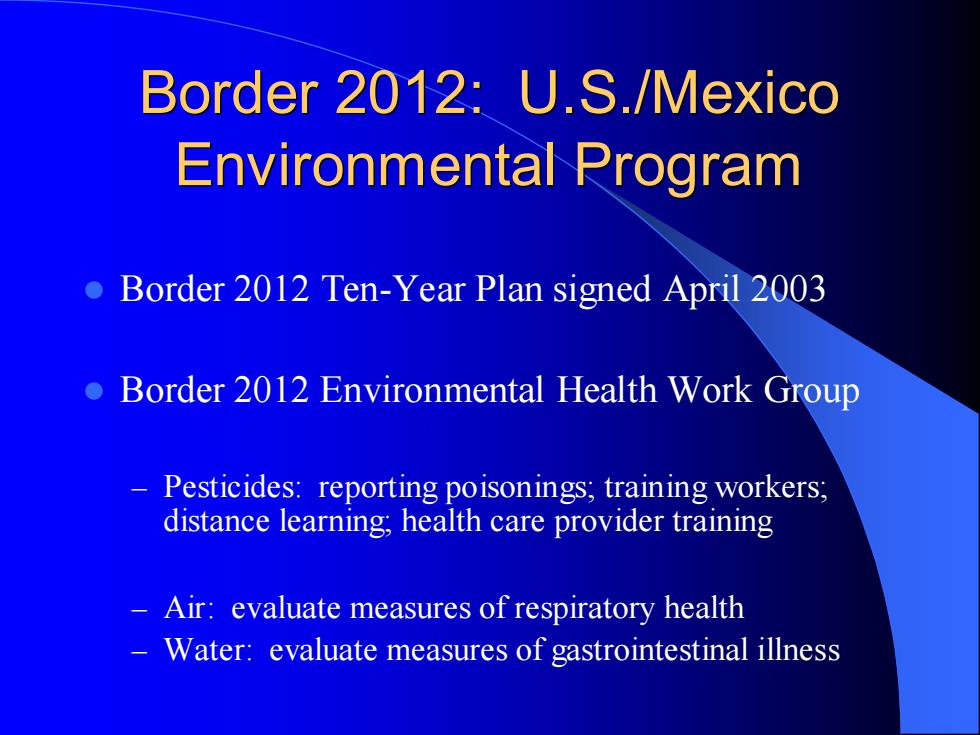
Border 2012:U.S./Mexico Environmental Program Border 2012 Ten-Year Plan signed April 2003 Border 2012 Environmental Health Work Group -Pesticides:reporting poisonings;training workers; distance learning;health care provider training Air:evaluate measures of respiratory health Water:evaluate measures of gastrointestinal illness
Border 2012: U.S./Mexico Border 2012: U.S./Mexico Environmental Program Environmental Program z Border 2012 Ten-Year Plan signed April 2003 z Border 2012 Environmental Health Work Group – Pesticides: reporting poisonings; training workers; distance learning; health care provider training – Air: evaluate measures of respiratory health – Water: evaluate measures of gastrointestinal illness
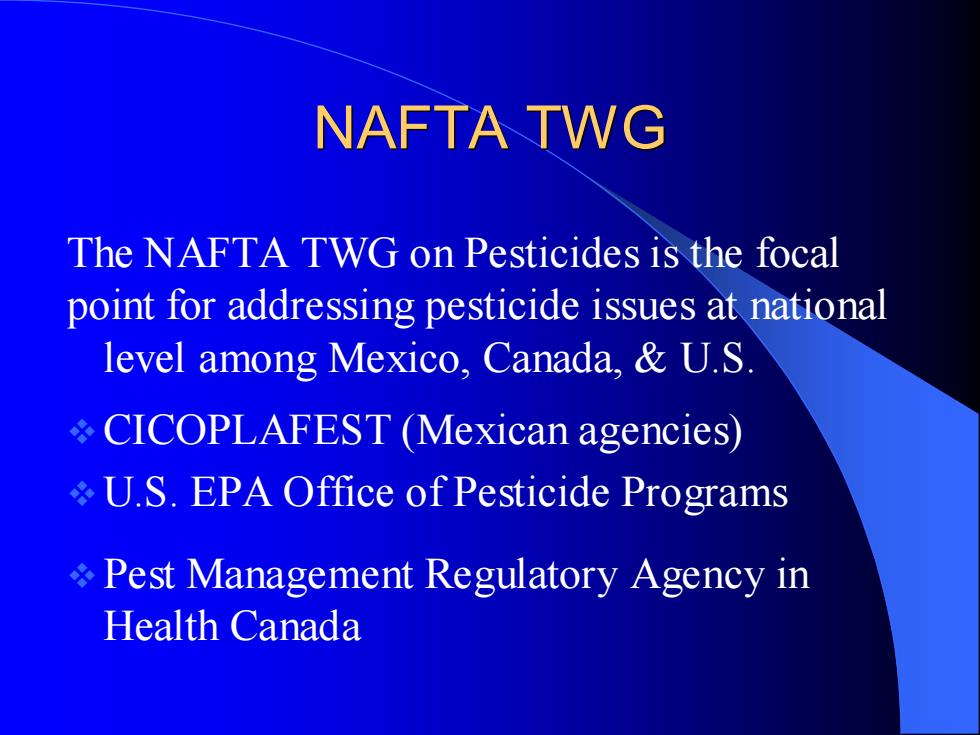
NAFTA TWG The NAFTA TWG on Pesticides is the focal point for addressing pesticide issues at national level among Mexico,Canada,U.S. CICOPLAFEST (Mexican agencies) U.S.EPA Office of Pesticide Programs Pest Management Regulatory Agency in Health Canada
NAFTA TWG NAFTA TWG The NAFTA TWG on Pesticides is the focal point for addressing pesticide issues at national level among Mexico, Canada, & U.S. CICOPLAFEST (Mexican agencies) U.S. EPA Office of Pesticide Programs Pest Management Regulatory Agency in Health Canada
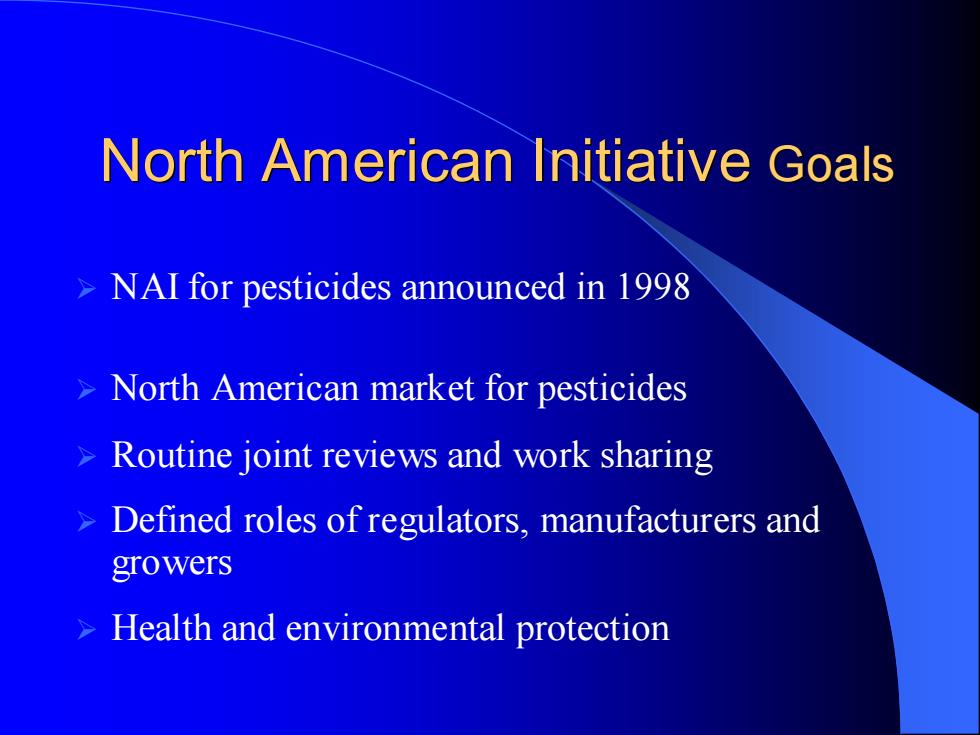
North American Initiative Goals >NAI for pesticides announced in 1998 >North American market for pesticides Routine joint reviews and work sharing > Defined roles of regulators,manufacturers and growers Health and environmental protection
North American Initiative North American Initiative Goals ¾ NAI for pesticides announced in 1998 ¾ North American market for pesticides ¾ Routine joint reviews and work sharing ¾ Defined roles of regulators, manufacturers and growers ¾ Health and environmental protection

NAFTA TWG Accomplishments (1st Five Years) ●l5 joint reviews plus work●NAFTA label-a shares. biopesticide NAFTA label ●Harmonized: was produced and will be used in Canada Most data requirements and ● protocols. Resistance Management Most data review templates Labeling. ● Worker Protection Eco-region residue zone Program maps. Milestone Report (2001) Process for addressing Trilateral document. trade irritants.' List of accomplishments
NAFTA TWG NAFTA TWG Accomplishments Accomplishments (1st Five Years) Five Years) z 15 joint reviews plus work shares. z Harmonized: – Most data requirements and protocols. – Most data review templates. z Eco-region & residue zone maps. z Process for addressing ‘trade irritants.’ z NAFTA label – a biopesticide NAFTA label was produced and will be used in Canada z Resistance Management Labeling. z Worker Protection Program. z Milestone Report (2001) – Trilateral document. – List of accomplishments

New Five Year Initiative (Dec2003) Vision:North America to serve as the world model in the safety of foods and pesticide products and in the training of the pesticide labor force. o Three additional ●Four Work Areas objectives -Trade. -Full North American Safety. Collaboration. Sustainability. Equal Access. Communication. Broadening the Dialog
New Five Year Initiative New Five Year Initiative (Dec 2003) (Dec 2003) z Three additional objectives – Full North American Collaboration. – Equal Access. – Broadening the Dialog. z Four Work Areas – Trade. – Safety. – Sustainability. – Communication. Vision: North America to serve as the world model in the safety of foods and pesticide products and in the training of the pesticide labor force

Reducing Pesticide Risks to Workers Mexico/U.S.program-initially NAFTA TWG Recognizes common work force Coordination of regulatory educational pesticide programs Includes farm owners,pesticide applicators,farm workers their families Train-the-Trainer>then train the workers Coordination between NAFTA TWG&Border 2012
Reducing Pesticide Ri Reducing Pesticide Risks to Workers to Workers z Mexico/U.S. program – initially NAFTA TWG – Recognizes common work force – Coordination of regulatory & educational pesticide programs – Includes farm owners, pesticide applicators, farm workers & their families – Train-the-Trainer Î then train the workers z Coordination between NAFTA TWG & Border 2012

Program History U.S.Mexico collaboration through a working group as part of NAFTA. Mexico's adoption of regulations that were similar to U.S.worker protection regulations. Coordinated efforts for education on risks of pesticide use and safe handling techniques. o U.S.pilot funding.Mexico ongoing funding
Program History Program History z U.S. & Mexico collaboration through a working group as part of NAFTA. z Mexico’s adoption of regulations that were similar to U.S. worker protection regulations. z Coordinated efforts for education on risks of pesticide use and safe handling techniques. z U.S. pilot funding. Mexico ongoing funding